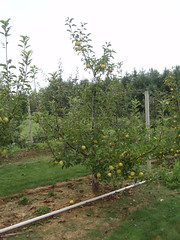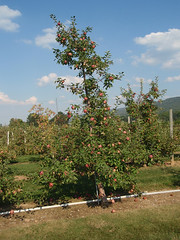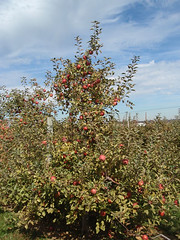| Characteristic | Detail | Description |
|---|---|---|
| Rootstock | M.26 |
Resulted from a cross between M.16 and M.9 in 1929, at the East Malling Research Station, Maidstone, Kent, England. Traditionally considered a dwarf rootstock, but is one of the more vigorous dwarfing rootstocks. M.26 is grown widely throughout the world and is included as a “standard” in many rootstock trials. M.26 is precocious and very productive, produces many burrknots, and is susceptible to crown rot and fire blight. In a joint effort to produce virus free rootstocks, the East Malling and Long Ashton Stations in England used heat treatments to eliminate known viruses and released M.26 EMLA. A similar virus indexing program in the Netherlands released M.26 NAKB. In general, virus-free rootstocks are slightly more vigorous than the original that contains viruses. Two strains of M.26 were compared in the 2002 NC-140 trial at nine locations with the scion ‘Gala’. Trees on M.26 NAKB were slightly more vigorous than trees on M.26 EMLA at most locations and productivity was similar. |
| Synonyms | Malling 26 | |
| Origin | M-9 X M-16 | |
| Availability | Widely available | |
| Tree Size | 55-60% of standard | |
| Precocity | Very early | |
| Winter Hardiness | Hardy | |
| Suckering | Little | |
| Tree Support Needed | Yes | |
| Where tested within NC-140 or other research plantings | AR, BC, CA, CO, IA, IL, IN, MA, MI, MN, NC, NY, OH, OR, PA, UT, VA, WA, WI, GA, KS, ME, MO, NJ, TN, WV |



